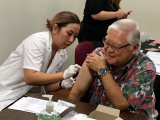Over the weekend, Argentinian health officials announced that Legionella was isolated from samples from four people infected in an unexplained cluster of bilateral pneumonia at a hospital that triggered fears of a possible outbreak of a new pathogen.
In the outbreak centered at a private facility in Tucuman province, in separate reports over the past few days, officials reported 9 more cases and 3 more deaths, raising the outbreak total to 19 cases, 6 of them fatal.
Tests indicate Legionalla pneumophilia
In a Sep 3 statement, provincial health officials said the three of the samples that tested positive were respiratory samples from sick patients, and the other was a puncture biopsy from one of the patients who died. They said the Legionella bacteria were still being subtyped, but they suspect it is Legionella pneumophilia.
Legionella can be transmitted through inhalation through water or air conditioning. Officials said it is safe to transfer patients to another facility so that investigators can examine the water and air conditioning systems in the affected hospital.
The World Health Organization (WHO) said in a statement that tests at Argentina's national lab had were negative for several respiratory viruses and bacteria and that tests were negative for the urinary antigen for Legionella. More detailed DNA testing on two bronchoalveolar lavage samples were consistent with Legionella species, with further testing suggesting that the results were compatible with Legionella pneumophilia.
"This laboratory result supports evidence compatible with Legionnaires' disease. Blood culture and seroconversion tests continue to be conducted to complement the diagnosis of Legionella infection," the WHO said. Though uncommon, Legionnaires' disease is a known cause of community- and hospital-acquired pneumonia.
Three healthcare workers died
All of the patients with confirmed infections have connections to the hospital. Of the 11 cases and 4 deaths covered in the WHO statement, 8 involved healthcare workers and 3 involved patients.
And of the four deaths, three occurred in healthcare workers. So far, no secondary infections have been identified. Symptoms included bilateral pneumonia, fever, muscle pain, abdominal pain, and breathing difficulty.
The WHO said environmental samples are being collected to identify the source of the contamination.
In a statement today, Tucuman health officials expanded the case inclusion criteria to include patients, caregivers, or health workers who had been at the hospital in August and developed any kind of pneumonia, not just bilateral (involving both lungs).
As a result, they added 8 more cases, which include 1 patient, 5 caregivers who were hospitalized, and 2 health workers. One is a stroke patient who is listed in serious condition.
Officials also announced two more deaths, one in an 81-year-old person and the other in a 64-year-old patient. Nine people are being treated at home for mild or moderate infections.




















